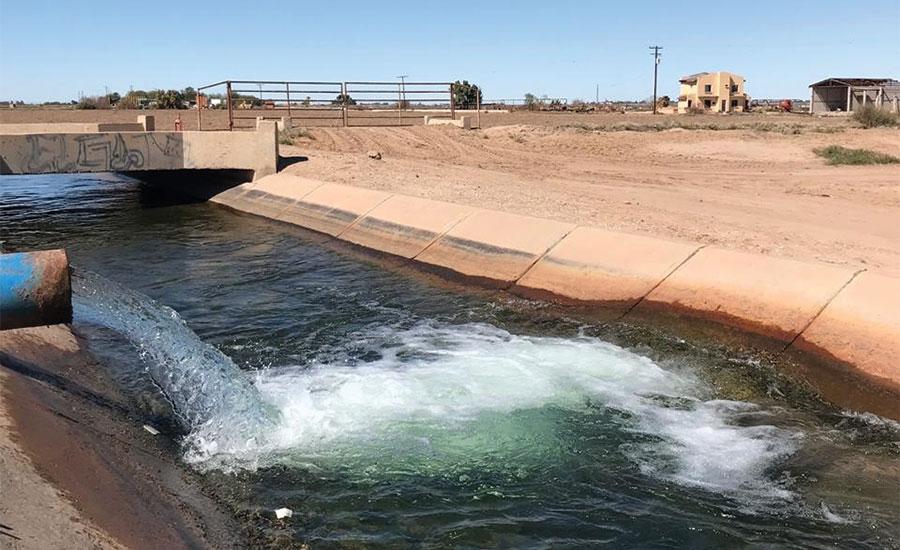
Clean, safe groundwater is one of our most valuable and essential resources on this planet. It is the duty of groundwater professionals to protect this valuable resource for future generations. Good well construction practices, including grouting and/or sealing water wells from the top of the well screen all the way to the surface, ensure no pathways for surface contamination to the water we count on. This practice also ensures that poor aquifers don’t comingle with good production aquifers.
Groundwater contamination can come from many sources. These sources include:
- Industrial waste
- Chemical and hydrocarbon contamination from refinery operations or leaky tanks
- Pesticides, fertilizers and/or animal waste runoff from agricultural applications
- Septic systems
- Contaminated aquifers that are above desirable aquifers
Many states require contractors installing domestic water wells to grout or seal only the upper 10 to 20 feet of the well. This leaves a void (the annular space below the sealed area) that can potentially serve as a pathway for contamination to enter the aquifer. Ideally, after the water well is drilled and the casing and gravel pack are in place, a tremie line is lowered to just above the gravel pack/well screen area. Grout is pumped through the tremie line to displace drilling fluid and fill the annular space.
Good well construction practices … ensure no pathways for surface contamination to the water we count on.
While working in the northern Baja California area of Mexico, I was asked to look at some large irrigation wells. The issue was that the steel casing was being destroyed in as few as five years from installation. Before going out into the field to inspect the well sites, we stopped in at the drilling contractor’s facility. There we found everything, including drill pipe, tooling and casing, laying on the ground (a source for iron bacteria). It was apparent as we approached the first well site that the well was pumping into a concrete ravine; the ravine collected the water and distributed it to many agricultural fields in the area. At the water line, a bright red rust line was visible and the water smelled of rotten eggs (a tell-tale sign of iron bacteria). The 400+ irrigation wells were over 800 feet deep. The annular space was not grouted from the well screen to the surface, and therefore, one can assume that everything from fertilizers to pesticides being sprayed on the crops was eventually finding its way into the aquifer used to supply water to the fields. It is also safe to assume that iron bacteria picked up by tooling, drill pipe and casing lying on the ground was being transferred back into a nutrient-rich environment. Fertilizers were finding their way into the aquifer (high nitrogen and phosphate levels could be detected in the water), resulting in the rapid failures to the steel casing.
Another example of poor grouting and sealing practices that this writer personally witnessed was on a large geothermal heating and cooling installation. The project was at a military base on the southern coast of South Carolina. Hundreds of geothermal loops were installed to a depth of 200 feet and, to comply with state grouting and sealing regulations, the annular space was sealed to a depth of 20 feet from the surface. Unfortunately, the holes penetrated a saltwater aquifer that was above a good freshwater aquifer, which was a major water source for a large metropolitan area. The open geothermal holes became a pathway for the denser saltwater to easily migrate down into the good fresh water aquifer and became a source of contamination. To make matters worse, the geothermal heating and cooling systems did not function correctly because the holes lacked the thermally enhanced grout needed to correctly exchange temperature between the loops and the surrounding ground. The properly installed geothermal grout would also have prevented the commingling of aquifers and guarded against surface contamination.
The solution to the above-mentioned scenarios is good grouting and sealing practices. Drilling professionals must also be knowledgeable in selecting the proper grout for their applications. For example, a 20-percent high-solids bentonite grout may work well for areas where the ground stays moist, but in areas with large vadose zones, a 20-percent solids bentonite grout (i.e., 20 percent solids/80 percent water) can desiccate (dry out and shrink). The grout will not adequately rehydrate to protect the wells and aquifers from contamination. In the vadose zone, a higher-solids-content grout, such as a grout/sand mixture, may be required.
A grout also must be significantly heavier than the drilling fluid that it will displace in order to properly seal the annular space. Years ago, I heard a contractor in southern Florida complain about experiencing grout failure with 20-percent solids bentonite grout. In fact, they were drilling with a high-solids drilling fluid that weighed 11.5 pounds per gallon and they were trying to displace with grout that weighed only 9.5 pounds per gallon. Naturally, the lighter bentonite grout quickly floated to the surface. It was like oil in water; the result was an inadequately grouted water well where an undesirable upper water table that was high in iron migrated and commingled with a good aquifer.
Passing on safe drinking water to future generations depends on good well construction practices. This includes grouting and/or sealing water wells from the top of the well screen all the way to the surface. This is the only way to ensure that the wells we use to obtain clean and safe drinking water are not the pathways for contamination.
